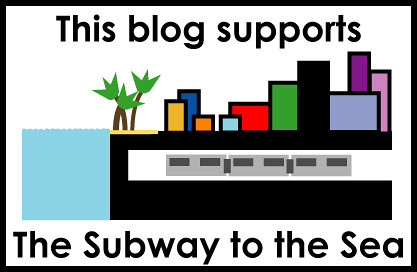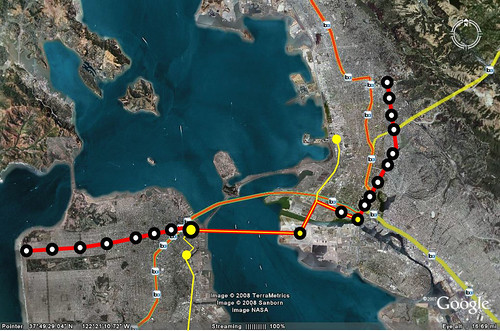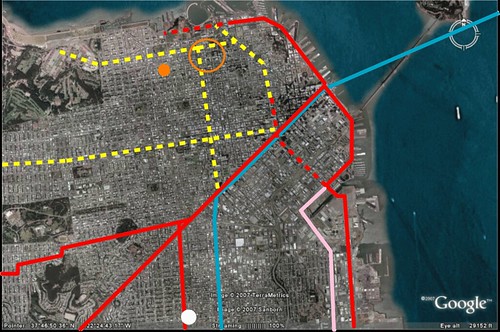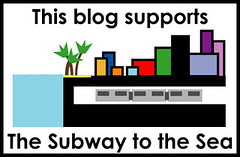Wednesday, March 10, 2010
Movement Depression and the Way Forward
Houston - The Mayor questions whether there is money to pay for two lines of the new five line light rail expansion in the city.
Austin - The Mayor decides its not time to have a bond election to pay for a future urban rail line.
Scotland - The company building Edinburgh's tram wants to delay 30 months after the rough ride they have already had.
Tampa - Ballot issue for rail dead for now due to lack of decision in how much of the funding would go to the rail project.
Bellevue: The city council is a bunch of morons there and don't want to run the line through a dense employment center.
There is a ray of hope out there. The Mayor of Los Angeles made me feel a bit better recently when he decided that he was going to ask to get things done faster. Ask for a loan so you can save billions in construction costs and have something built for your money faster. I would like to think that is how we work in the United States. But sometimes reading all the news I do just gets so depressing. At least someone has suggested a way forward. Whether we follow it or not is up to us.
Sunday, February 22, 2009
Stealth Developer
If any transportation agency was going to be a true development agency it would have even more power to land bank and develop properties than is currently allowed in the United States. In fact, this is how transportation worked during the streetcar era. Property was the main money maker rather than transportation, the transportation was the hook. But it created some great places such as the inner ring suburbs we now love. I would love to see transit agencies have more power to develop, but surely that won't happen because of property rights activism among other barriers.
Wednesday, January 7, 2009
Thursday, November 20, 2008
GMing the System
He recently redeemed himself when he helped to lift the ban, but let's hope there aren't any more of these types of issues. To be fair, I don't see any of these problems arising and I see a new generation shift. We're looking at the environment, energy and transportation different than before. And the vote today shows that shift happening.
Sources inside the Democratic House Caucus say the vote against outgoing Energy and Commerce Committee Chairman Rep. John Dingell turned partly along generational lines - with young turks lining up against the old - and partly because of Dingell's record on environmental issues.They would have gotten away with it, if it weren't for those pesky kids.
Thursday, October 16, 2008
Measure AAARRRR
Tuesday, September 2, 2008
Subway to the Sea Moves Along
 to this:
to this:
Of course its going to take a large chunk of green to make this happen but how else are you going to build people moving capacity for increased density along the line. Here's the badge again, if anyone wants to use it.

Thursday, July 24, 2008
And So It Begins...
Sunday, July 13, 2008
The LA Subway of 1925
As plans rolled forward, the city's charter was being revised to allow for a subway to run parallel to a street, an action prohibited at the time by the charter in place. By August, PE was on board, provided the additional capital could be located, to have the station built under the Olive side of Pershing Square, in the hopes that the subway would one day extend further to travel beneath Olive ("Subway Extension"). So it was underground at Pershing versus at-ground level at Hill Street, with citizens registering agreement and disagreement on all sides. By mid-August 1924 action on either plan was delayed until September while all concerned parties weighed their options. (To those of us looking back from where we stand now with transit expansion, the delays seem all too familiar.)
Wednesday, June 25, 2008
Hold That Thought...Until November
Thursday, March 13, 2008
It's Space Race Time, and LA is Rockin!
From Curbed LA:
Strategic Unfunded Projects
Tier 1: Currently Under Planning or Environmentally Cleared/Route Refinement Study-Regional Connector
-Metro Subway Westside Extension to La Cienega
-Harbor Subdivision Alternate Rail Technology between LA Union Station and Metro Green Line Aviation Station
-Metro Subway Westside Extension to City of Santa Monica
-Burbank/Glendale Light Rail from LA Union Station to Burbank Metrolink Station
-Metro Gold Line Eastside Extenstion from Atlantic/Pomona Station to City of Whittier
-Metro Gold Line Foothill Extension from Sierra Madre Villa Station to Azusa
-Metro Green Line Extension from Redondo Beach Station to South Bay Galleria
-Metro Gold Line Extension from Sierra Madre Villa Station to Montclair
-Metro Green Line Foothill Extension between Norwalk Station and Norwalk Metrolink Station
-Mero Green Line Extension to LAX
-West Santa Ana Branch ROW Corridor Maglev between LA Union Station and Santa Ana Metrolink StationTier 2
-Metro Red Line Extension from North Hollywood Station to Burbank Airport Metrolink Station
-Vermont Corridor Subway
-"Yellow" Line Light Rail between Metro Red Line North Hollywood Station and Regional Connector
-I-405 Corridor Busway between Metro Orange Line Sepulveda Station and Metro Green Line Aviation Station
-"Silver" Line Light Rail between Metro Red Line Vermont/Santa Monica Station and City of La Puente
-Metro Green Line Extension from LAX to Expo Santa Monica Station
-SR-134 Transit Corridor Bus Rapid Transit between Metro Red Line North Hollywood Station and Metro Gold Line Del Mar Station
-Metro Green Line Extension between South Bay Galleria and Pacific Coast Hwy Harbor Transitway Station

Sunday, March 2, 2008
Subway to the Sea Badge
In an earlier post I discussed blog support badges and listed some I'd like to see. I created one for the Subway to the Sea for kicks. Feel free to use it.
Monday, January 21, 2008
"...They Wasted Everyone's Time and Money"
In the Washington Post there was an article which discussed that even though the Dulles Airport Extension to Metro has gone through all of the hoops that the FTA has set up for it, it might still not get funded. Why? Because the Bushies don't like rail transit. In fact they don't like it so much that they are willing to kill it because of a famous road project that cost way more than it was supposed to and still hasn't delivered on its environmental offsets; The Big Dig.
Federal officials remain skeptical of the plan to extend Metrorail to Dulles International Airport and might reject it, even though their consultants recently found that the proposal meets requirements for full funding, government and project sources said.And what is this comment about moving away from infrastructure as Quade points out? Surely that can't be true? Why didn't they say the same thing about three other projects in the New Starts pipeline that have big budgets? Seattle's line to the University($1.6 Billion), New Jersey's Access to the Core ($7.3 Billion), and the Long Island East Side Access Project ($2.6 Billion). But the Dulles project is about $2.06 Billion. So what's the rub? Why pick on this project? This screams a basic ideological bias. But tell us something we didn't know right? Congressional backers of the project even stated to the Post:
Officials with the Federal Transit Administration say they are concerned about the price tag and the specter of another Big Dig, the Boston project built by the same contractor in charge of the Dulles rail line, which took years longer and cost millions more than planned, according to the sources, who spoke on the condition of anonymity because the negotiations are sensitive. In addition, the agency has been reluctant to promote large-scale transit projects.
Officials on Capitol Hill, in Richmond and at the airports authority's headquarters have speculated in recent days about what the problem might be. Some say the FTA has long been skeptical of expensive rail projects; in recent years, it has more often championed bus rapid transit projects.Bingo. There has been no recent evidence to be against big rail projects. In fact does anyone know of a big rail project that hasn't delivered recently? I know the Silver Line BRT in Boston hasn't delivered on promises and locals call it the Silver Lie but light rail projects in Denver, Houston, Charlotte, Minneapolis and St. Louis have delivered, all of them far exceeding ridership projections.
But basically the DOT is waging an ideological battle. And so far, as Ryan states at The Bellows quite succinctly, "...they wasted everyone's time and money".
As the linked Post piece makes clear, it’s not the Silver Line’s specifics that are the issue, it’s an ideological opposition to big new transit lines. I think that’s dumb, but I think it’s even more dumb to nonetheless pretend that normal operating rules apply with regard to consideration of big new transit lines only to back out for ideological reasons after all the planning has been done and construction is underway. At any moment during this process, the feds could have said, we’re not going to go ahead with this money, because we don’t like new heavy rail lines. Instead, they wasted everyone’s time and money.
This comes just a few days after the release of a National Surface Transportation Commission Report panned by DOT Secretary Mary "Bikes Aren't Transportation" Peters where the dissenting side led by the Secretary claimed falsely that there were not enough cost-effective rail projects to spend money on. Looks like there is a project in DC that needs some money and has merit. And there are more like it such as the Subway to the Sea in Los Angeles.
But in addition, there have been rumors floating around that certain pieces of that report pertaining to light rail and electric transit were approved by the commission but taken out mysteriously before the final printing. When learning about pro-rail segments being taken out of the report, Commissioner,Staunch Conservative, and rail advocate Paul Weyrich stated,
“It is disappointing that after the paragraphs indicated were passed by a nine to three vote that someone without ever asking me would see to it to do away with these important policy considerations, Weyrich said to NCI. “ It is the kind of gutter politics which make people hate their government, and Washington in general."Now we know where the battle lines are drawn. It's time for a new direction.
Sunday, January 13, 2008
Thinking Big: The Next Bay Area Project
But that isn't what i really wanted to talk about. I have a new idea for the Bay Area's newest New Start/Transit Project. I'd like to call it the Subway to the Sea 2, Urban Core Capacity Enhancement. The title is a nod to the Subway to the Sea bubbling up in LA and the New Jersey Access to the Core tunnel under the Hudson. If we're going to densify the bay area further, we need more of a metro system along major corridors. We need to be cost effective, so we should start with a corridor that would generate a lot of new ridership. So how about we build a line between the beach and downtown on Geary, build the new trans-bay tube that's been planned, and build up Broadway in Oakland to Rockridge and Berkeley under the 51 line.
Current ridership in this corridor is 56,000 for Geary and 18,600 boardings on the 51. This means that if everyone changed modes (which we know there still has to be a surface bus line for shorter trips) there could be about 80,000 riders. Given the speed of the new line and convenience it could increase ridership to way over 100,000 a day just on the line. This is a third of BART's ridership. Now the line is 19 miles from Berkeley to the Sea along the route I mentioned.
Now the line wouldn't just generate a lot of ridership, but it would generate a lot of new TOD, Office and Residential. In Oakland on Broadway, there would be a surge in new development along the corridor between College Avenue and Downtown. It's possible to capture a lot of the office and residential markets and take some pressure off of the outer sprawling suburbs. It will also take pressure off of the almost at capacity Transbay Tube.
Another feature of this would be the tunnel under the bay. it should be designed to be dual mode so that Caltrain/HSR could go to Oakland, Emeryville, and/or Jack London Square. That way Caltrain could extend into downtown and across the bay to Emeryville and possibly beyond making a connection between the jobs there and Silicon Valley (Yellow). It's possible to electrify the line all the way up to Martinez making commutes from around the horn easier with new stations in North Richmond and Hercules. It might also provide a way to keep trains away from Jack London which has had some issues with accidents. It would be a big project and more than likely cost a lot of money, but it will also be a huge ridership generator. Not only will you get over 100,000 from the subway alone, there will be the tens of thousands that want to get across the bay with a one seat ride to Emeryville and Jack London Square.

Saturday, December 8, 2007
When Alternatives Analysis is a Wasteful Exercise
I understand doing an AA on a new corridor and in some places BRT is the best tool for the job, but forcing a study of it as an alternative when its obviously a waste of money is ridiculous. Use it to study different route alternatives instead. Besides, it looks like we are going to have to save all the money we can with the crazy inflation that is going on and the lowering of the dollar's value against other world currencies.
Saturday, November 3, 2007
Why Not Build Both?
Sunday, October 21, 2007
Six New Subway Lines to Start Construction By End of Year
Beijing's urban planning authorities have approved planning permission for six new subway lines on which work is scheduled to begin by the end of the year.The six new lines - the No. 6, 8 and 9 lines, the second phase of the No. 10 line, and the Yizhuang and Daxing lines, have a total length of 152 kilometers, according to the Beijing Municipal Commission of Urban Planning. They will be completed in 2012.
Beijing currently has five subway lines in operation, with a total length of 142 kilometers.
"The city aims to raise the proportion of citizens choosing public transport from the current 30 percent to 45 percent by 2015,and the subway passenger volume will increase to eight million a day from the current 2.2 million," said the commission's Zhou Nansen.
8 million a day is huge. New York City gets about 6.2 million a day. But what is interesting is that they set a goal to reach in terms of percentage of total and figure out what they need to do to reach it. It certainly would be exciting if a major city in the United States was building 6 new lines and LA comes to mind as a city that might want to do that.
Saturday, October 20, 2007
LA Rockin The Transit Space Race
The Crenshaw Corridor
Gold Line Foothill Extension
Expo Line Phase 2
Downtown Connector
Subway to the Sea
It's getting busy down there in LA, now if only they could speed it up and build them all at once like Denver, Houston, and Salt Lake City.
Wednesday, September 19, 2007
We Need Subways, But How Will We Pay For Them?
Now here's an idea, lets pay for transit lines like we used to, tie them to real estate. Obviously this isn't a way to pay for the whole line (unless zoning was lifted and there was a development free for all) but it should be considered for partial funding. It's possible that a development fund could be put together to fund stations, or private developers could bid to build high rises with the stations. I'm sure there are a lot of other innovative ways to create a TIF district. Maybe there could be a roof tax for every new unit along the line. Anyone have any innovative ideas for funding transit?
San Francisco
Speaking of subway dreams, Polk Street Blog reminds everyone that there will be a BRT planning session for Van Ness in San Francisco. I'm kind of upset that I'm going to miss it because I would have gone and raised some issues with the BRT scheme. This is one of the lines that I think should be a Subway and for two reasons(they both might fit into the same reason):
A. Van Ness is the main through street to get from 101 South to the Golden Gate Bridge. The street is already crowded and on many days traffic does not move an inch. I'm not asking for a freeway because that would be a dumb idea (one that almost happened). But taking away two lanes on the busiest North-South street in town for buses that will still get caught in cross traffic every block? Could ITS realistically keep up with that? There are 31 crossings from Fort Mason and Market street which is only 2 miles.
B. I want to get to the other side of the city in less than 45 minutes and I don't think that is possible on the surface streets. By other side of the city I mean 3 miles between my house(white dot) and the bar where I watch UT play football(Orange Dot) and my friends Mark and Ade live(Orange Circle). It's like I have to plan a day just to see them without driving my car. Taking the J to the 47/49 is a fun bumpy people watching experience, but I imagine I could cut this trip to 25 minutes with a subway which would make it about the same convenience as my car (more so because I don't have to park).
So zone up Van Ness and do it with TIF districts. Make the Van Ness/Geary/Subway to the Sea a state TIF project to see if it works. If it doesn't work as well as it should, well these are good projects that should be funded anyways, if it does work, it can act as a model for cities around the country who might want to build a subway line or extension.
I've made this map before but just so people can see what I'm talking about check out the map below. The blue line is BART, the Red lines are existing MUNI Metro lines. The red dashed lines are planned rail extensions and the yellow dashed lines are subway projects I wish would happen so I can eat dim sum on Geary or watch the UT games on Union without spending 2 hours on the bus and J.
Ridership on the largest bus lines in SF is in this article.

Thursday, September 6, 2007
The Limited Vision Line
Sunday, August 26, 2007
China's Subway Boom
Brian Taylor, a professor of urban planning at UCLA, noted that the United States used to be much more heavy-handed in its planning policies. Consider, for instance, the way whole swaths of central Los Angeles were razed to make way for the Santa Monica Freeway. Perhaps, he said, China is simply at a different stage in its evolution, both in terms of economic development and political participation.
From about 1890 to the late 1970s, he said, Los Angeles expanded its transportation system at an astonishing rate, first building the world's most extensive streetcar system and then tearing it down and building the world's first and largest freeway network.
"So it's not as if we haven't had these enormous investment eras in transportation infrastructure," Taylor said.
Cities "go through these various epochs of growth," he said, and at the moment, Los Angeles is in a very different stage than Shanghai.

